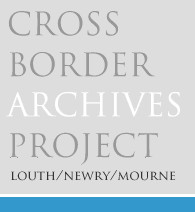Landowners of County Louth
The Clermont/Fortescue Estate
The Fortescue family of Dromiskin had its origins in the 17th century when Sir Faithful Fortescue (c.1581-1666), a royalist army officer, bought the Dromiskin lands from Sir Moses Hill. The Dromiskin estate was consolidated by the next generation, when Sir Thomas Fortescue purchased several of the surrounding freeholds.
Thereafter, the two descending branches of the Fortescue family (Sir Thomas's sons Chichester and William) accumulated substantial acreage in County Louth and elsewhere. The branch descended from Chichester Fortescue (d. 1689) continued to hold the estate at Dromiskin, while the branch descended from William Fortescue (d. 1734) went on to accumulate a vast estate which included Reynoldstown (now Clermont Park) and Ravensdale in County Louth, and Grangegeeth in County Meath, as well as an elevation to the Irish peerage in 1776 with the title Viscount Clermont, which was swiftly raised to an earldom. William Henry Fortescue was the first, and only Earl of Clermont. His death without a direct male heir in 1806 meant that the earldom was extinguished, the viscountcy and the Clermont estates passing to his nephew, William Charles Fortescue. The estate now suffered accordingly, being successively by middle-aged owners for relatively short periods of time due to a lack of direct male heirs. William Charles Fortescue died in 1829 without male issue , thus causing the viscountcy to be extinguished. The estate then passed to William Charles's cousin Sir Harry James Goodricke, whose death in 1833 resulted in the unification of the estates of the two branches of the Fortescue family when Thomas Fortescue inherited the Clermont estate, in addition to the Dromiskin property.
Thomas Fortescue's estate in County Louth extended to c. 20,000acres at the time of Griffiths Valuation in 1854. It was concentrated around Dromiskin and Ravensdale, but also included townlands in the vicinity of Ardee and Tallanstown. Thomas was elevated to the Irish peerage in 1852 as Lord Clermont, and was made a peer of the United Kingdom as Baron Clermont in 1866. Clermont had a better reputation as a landlord than his predecessors (the burial of William Charles had to be performed at night, such was the level of acrimony to the man whose soubriquet was 'the cockle lord' due to his attempts to impose taxes on the cockle gatherers at Blackrock and Lurgangreen). During the Famine he was active on relief committees and supplied his tenants with food and blankets. He also reduced rents on his estate by 30 percent in the wake of the poor harvests during the 1870s.
When Lord Clermont died childless in 1887, the estate passed to his brother Chichester Fortescue, Lord Carlingford. He too died childless in 1898, at which point a share of the estates at Ballymascanlon, Carlingford and Ravensdale passed to the 4th Viscount de Vesci.1
The Fortescue papers are held by the Public Record Office for Northern Ireland, see www.proni.gov.uk or click to view the PRONI introduction to the Fortescue papers (pdf file).
Footnotes:
1. Malcomson, A.P.W., The Pursuit of the Heiress: Aristocratic Marriage in Ireland 1740-1840 (Belfast 2006). William Henry, the 1st Earl of Clermont, left a series of remainders in his will. The death of Lord Carlingford in 1898 activated an inheritance which descended from William Henry's sister Margaret, whose daughter Selina Elizabeth Brooke married the 1st Lord Knapton and was the mother of the 1st Viscount de Vesci.
- home |
- about project |
- online catalogue |
- online exhibitions |
- activities |
- oral history collection
- about us |
- contact us |
- legal |
- acknowledgements
© Cross Border Archives Project . Website design and development by morsolutions.
This project is part financed by the European Union through the Interreg IIIA Programme managed for the Special EU Programmes Body by the East Border Region Interreg IIIA Partnership.




